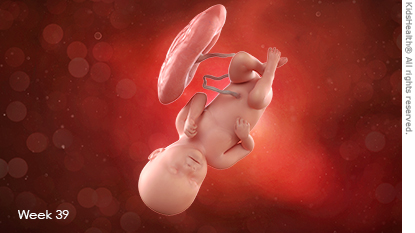Pregnancy Calendar: Week 39
Your Baby's Development
Umbilical cords usually are about 22 inches (55 cm) long and half an inch (1–2 cm) thick. Sometimes, the cord can get wrapped around a baby's neck. This usually won't be a problem unless it puts pressure on the cord during labor or delivery. In that case, a woman might need a C-section. A true knot in the umbilical cord happens much less often (in about 1% of pregnancies).
Most of the vernix that covered your baby's skin has disappeared, as has the lanugo. Your body has been supplying the baby with antibodies through the placenta that will help your little one's immune system fight infection for the first 6–12 months of life.

Your Body
 Braxton Hicks contractions may become more pronounced. Also called "false labor," these contractions may be as painful and strong as true labor contractions, but don't become regular or increase in frequency as true contractions do.
Braxton Hicks contractions may become more pronounced. Also called "false labor," these contractions may be as painful and strong as true labor contractions, but don't become regular or increase in frequency as true contractions do.
Another sign of labor, the rupture of the amniotic sac's membranes (when your "water breaks"), could happen any day now. Some women have a large gush of water, while others feel a steady trickle. Often, a woman's water doesn't break until she's well into labor. To start or speed up their labor, some women will need to have the membranes ruptured by their health care provider.
If you think your water has broken or you're having regular contractions, call your health care provider.



